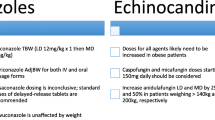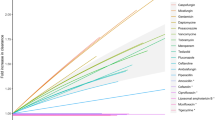Abstract
Obesity is becoming a global pandemic that is projected to increase significantly over the next few decades. Unfortunately, studies of drug dosing and pharmacokinetics have largely excluded obese patients. Currently, literature inadequately characterizes drug disposition in these patients. Only a limited selection of literature addresses antibacterial dosing in obesity, and virtually none characterizes antifungal dosing in obesity. This review discusses the changes in pharmacokinetics that occur in obesity and the available in vitro and in vivo data describing the disposition of antifungal agents in obese animals and patients.
Similar content being viewed by others
References
Papers of particular interest, published recently, have been highlighted as: • Of importance
World Health Organization: Obesity and Overweight. Available at: http://www.who.int/mediacentre/factsheets/fs311/en/index.html. Accessed October 28, 2010.
Wang Y, Beydoun MA, Liang L, Caballero B, Kumanyika SK. Will all Americans become overweight or obese? Estimating the progression and cost of the US obesity epidemic. Obesity. 2008;16:2323–30.
Blouin RA, Warren GW. Pharmacokinetic considerations in obesity. J Pharm Sci. 1999;88:1–7.
Cheymol G. Effects of obesity on pharmacokinetics: implications for drug therapy. Clin Pharmacokinet. 2000;39:215–31.
• Hanley MJ, Abernathy DR, Greenblatt DJ. Effect of obesity on the pharmacokinetics of drugs in humans. Clin Pharmacokinet. 2010;49:71–87. This review is the most recent update of the effects of obesity on human pharmacokinetics. The authors provide a thorough discussion of the different derivations of weight descriptors and their utility. This article also provides complete descriptions of drug disposition: volume of distribution, clearance, half-life, and the variations of these parameters in obese patients. It also thoroughly reviews the available literature on dosing of individual drugs and drug classes in obese patients.
Wurtz R, Itokazu G, Rodvold K. Antimicrobial dosing in obesity. Clin Infect Dis. 1999;25:112–8.
Bearden DT, Rodvold KA. Dosage adjustments for antibacterials in obese patients: applying clinical pharmacokinetics. Clin Pharmacokinet. 2000;38:415–26.
Erstad BL. Dosing of medications in morbidly obese patients in the intensive care unit setting. Intensive Care Med. 2004;30:18–32.
Pai MP, Bearden DT. Antimicrobial dosing considerations in obese adult patients. Pharmacotherapy. 2007;27:1081–91.
Devine D. Case Study Number 25 Gentamicin Therapy. Drug Intell Clin Pharm. 1974;8:650–5.
Saadeh S. Nonalcoholic fatty liver disease and obesity. Nutr Clin Pract. 2007;22:1–10.
Cheng P-Y, Morgan ET. Hepatic cytochrome P450 regulation in disease states. Curr Drug Metab. 2001;2:165–83.
Janmahasatian S, Dufffull SB, Ash S, Ward LC, Byrne NM, Green B. Quantification of lean body weight. Clin Pharmacokinet. 2005;44:1051–65.
Han PY, Duffull SB, Kirkpatrick CMJ, Green B. Dosing in obesity: a simple solution to a big problem. Clin Pharmacol Ther. 2007;82:505–8.
• Pai MP. Estimating the glomerular filtration rate in obese adult patients for drug dosing. Adv Chronic Kidney Dis. 2010;5:e53-e62. This article thoroughly reviews the effect of obesity on GFR. The author reviews the derivations of the various GFR equations, Cockcroft and Gault, and their limitations in predicting GFR and creatinine clearance. He compares and contrasts the ability of calculated weight descriptors to predict GFR and provides the equations for each. Finally, he concludes with practical considerations for using our current GFR and creatinine clearance calculations and proposes the use of other weight descriptors in these equations to improve clinical estimates.
Slain D. Lipid-based amphotericin B for the treatment of fungal infections. Pharmacotherapy. 1999;19:306–23.
Atkinson AJ, Bennett JE. Amphotericin B pharmacokinetics in humans. Antimicrob Agents Chemother. 1978;13:271–6.
Janknegt R, de Marie S, Bakker-Woudenberg IA, et al. Liposomal and lipid formulations of amphotericin B: clinical pharmacokinetics. Clin Pharmacokinet. 1992;23:279–91.
Daneshmend TK, Warnock DW. Clinical pharmacokinetics of systemic antifungal drugs. Clin Pharmacokinet. 1983;8:17–42.
Brajtburg J, Elberg S, Bolard J, et al. Interaction of plasma proteins and lipoproteins with amphotericin B. J Infect Dis. 1984;149:986–97.
Collette N, Van der Auwera P, Van der Pascual Lopez A, et al. Tissue concentrations and bioactivity of amphotericin B in cancer patients treated with amphotericin B deoxycholate. Antimicrob Agents Chemother. 1989;33:362–8.
Craven PC, Ludden TM, Drutz DJ, et al. Excretion pathways of amphotericin B. J Infect Dis. 1979;140:329–41.
Walsh TJ, Goodman JL, Pappas P, Bekersky I, Buell DN, Roden M, et al. Safety, tolerance, and pharmacokinetics of high-dose liposomal amphotericin B (AmBisome) in patients infected with Aspergillus species and other filamentous fungi: maximum tolerated dose study. Antimicrob Agents Chemother. 2001;45:3487–96.
Gallis HA, Drew RH, Pichard WW. Amphotericin B 30 years of clinical experience. Rev Infect Dis. 1990;12:308–29.
Christiansen KJ, Bernard EM, Gold JWM, et al. Distribution and activity of amphotericin B in humans. J Infect Dis. 1985;152:1037–43.
Vadiei K, Lopez-Berestein G, Luke DR. Disposition and toxicity of amphotericin B in the hyperlipidemic Zucker Rat Model. Int J Obes. 1990;14:465–72.
Ramaswamy M, Peteherych KD, Kennedy AL, et al. Amphotericin B lipid complex or amphotericin B multiple-dose administration to rabbits with elevated plasma cholesterol levels: pharmacokinetics in plasma and blood, plasma lipoprotein levels, distribution in tissues, and renal toxicities. Antimicrob Agents Chemother. 2001;45:1184–91.
Brown CD, Higgins M, Donato KA, et al. Body mass index and the prevalence of hypertension and dyslipidemia. Obes Res. 2000;8:605–19.
Koldin MH, Kobayashi GS, Brajtburg, et al. Effects of elevation of serum cholesterol and administration of amphotericin B complexed to lipoproteins on amphotericin B-induced toxicity in rabbits. Antimicrob Agents Chemother. 1985;28:144–5.
Wasan KM, Kennedy AL, Cassidy SM, et al. Pharmacokinetics, distribution in serum lipoproteins and tissues, and renal toxicities of amphotericin B and amphotericin B lipid complex in a hypercholesterolemic rabbit model: Single-dose studies. Antimicrob Agents Chemother. 1998;42:3146–52.
Groll AH, Mickiene D, Piscitelli SC, et al. Distribution of lipid formulations of amphotericin B into bone marrow and fat tissue in rabbits. Antimicrob Agents Chemother. 2000;44:408–10.
Collette N, Van der Auwera P, Meunier F, et al. Tissue distribution and bioactivity of amphotericin B administration in liposomes to cancer patients. J Antimicrob Chemother. 1991;27:535–48.
Bellmann R. Clinical pharmacokinetics of systemically administered antimycotics. Curr Clin Pharmacol. 2007;2:37–58.
De Beule K, Van Gestel J. The pharmacology of itraconazole. Drugs. 2001;61 Suppl 1:27–37.
Theuretzbacher U, Ihle F, Derendorf H. Pharmacokinetic/pharmacodynamic profile of voriconazole. Clin Pharmacokinet. 2006;45:649–63.
Li Y, Theuretzbacher U, Clancy CJ, Nguyen MH, Derendorf H. Pharmacokinetic/pharmacodynamic profile of posaconazole. Clin Pharmacokinet. 2010;49:379–96.
Glassner-Cohen L, DiBiasio A, Lisco SJ, Hurford WE. Fluconazole serum concentrations and pharmacokinetics in an obese patient. Pharmacotherapy. 1997;17:1023–6.
Anaissie EJ, Kontoyiannis DP, Huls C, Vartivarian SE, Karl C, Prince RA, et al. Safety, plasma concentrations, and efficacy of high-dose fluconazole in invasive mold infections. J Infect Dis. 1995;172:599–602.
Wasan KM, Kennedy AL, Cassidy SM, et al. Pharmacokinetics, distribution in serum lipoproteins and tissues, and renal toxicities of amphotericin B and amphotericin B lipid complex in a hypercholesterolemic rabbit model: single-dose studies. Antimicrob Agents Chemother. 1998;42:3146–52.
• Pai MP, Lodise TP. Pharmacokinetics (PK) of voriconazole (VOR) in obese (OB) adults. Poster A1–044. Presented at the 50th Interscience Conference on Antimicrobial Agents and Chemotherapy (ICAAC); September 12–15, 2010, Boston, MA. Though currently available only in abstract/poster form and described in the article, this is one of the first comparative pharmacokinetic studies describing drug disposition of an antifungal agent (voriconazole) in obese patients. This study compares two different doses of voriconazole in obese patients and in historical, nonobese control patients. The study demonstrates no significant differences in apparent voriconazole pharmacokinetic values between obese and nonobese patients, but differences are noted when adjusted for average TBW. The authors further describe the correlations of TBW and LBW (2005) to AUC values. This article provides some much-needed evidence about the disposition of voriconazole in obese patients.
Estes KE, Penzak SR, Calis KA, et al. Pharmacology and antifungal properties of anidulafungin, A new echinocandin. Pharmacotherapy. 2009;29:17–30.
Gumbo T. Impact of pharmacodynamics and pharmacokinetics on echinocandin dosing strategies. Curr Opin Infect Dis. 2007;20:587–91.
Stone JA, Xu X, Winchell GA, et al. Disposition of caspofungin: role of distribution in determining pharmacokinetics in plasma. Antimicrob Agents Chemother. 2004;48:815–23.
Damle B, Stogniew M, Dowell J. Pharmacokinetics and tissue distribution of anidulafungin in rats. Antimicrob Agents Chemother. 2008;52:2673–6.
Groll AH, Mickiene D, Petraitis V, et al. Compartmental pharmacokinetics and tissue distribution of the antifungal echinocandin lipopeptide micafungin in rabbits. Antimicrob Agents Chemother. 2001;45:3322–7.
Ryan D, Lupinacci R, Kartsonis N. Efficacy and safety of caspofungin in obese patients [Abstract # 1040] in program and abstracts of the 47th annual meeting of the Infectious Diseases Society of America, October 29–November 1, 2009, Philadelphia, PA.
Stone JA, Winchell GA, Bi S, et al. Population pharmacokinetics of caspofungin in candidiasis patients [abstract A-1571]. Available in program and abstracts of the 43rd Annual Meeting of the Interscience Conference on Antimicrobial Agents and Chemotherapy, September 14–17, 2009, Chicago, IL.
Nguyen TH, Hoppe-Tichy T, Geiss HK, et al. Factors influencing caspofungin plasma concentrations in patients of a surgical intensive care unit. J Antimicrob Chemother. 2007;60:100–6.
Gumbo T, Hiemenz J, Ma L, et al. Population pharmacokinetics of micafungin in adult patients. Diagn Microbiol Infect Dis. 2008;60:329–31.
Hebert MF, Smith HE, Marbury TC, et al. Pharmacokinetics of micafungin in healthy volunteers with moderate liver disease, and volunteers with renal dysfunction. J Clin Pharmacol. 2005;45:1145–52.
Dowell JA, Knebel W, Ludden T, et al. Population pharmacokinetic analysis of anidulafungin, an echinocandin antifungal. J Clin Pharmacol. 2004;44:590–8.
Betts RF, Nucci M, Talwar D, et al. A multicenter, double-blind trial of a high-dose caspofungin treatment regimen versus a standard caspofungin treatment regimen for adult patients with invasive candidiasis. Clin Infect Dis. 2009;48:1676–84.
Vermes A, Guchelaar H-J, Dankert J. Flucytosine: a review of its pharmacology, clinical indications, pharmacokinetics, toxicity and drug interactions. J Antimicrob Chemother. 2000;46:171–9.
Gillum JG, Johnson M, Lavoie S, Venitz J. Flucytosine dosing in an obese patient with extrameningeal cryptococcal infection. Pharmacotherapy. 1995;15:251–3.
Disclosure
No potential conflicts of interest relevant to this article were reported.
Author information
Authors and Affiliations
Corresponding author
Rights and permissions
About this article
Cite this article
Amsden, J.R., Slain, D. Antifungal Dosing in Obesity: A Review of the Literature. Curr Fungal Infect Rep 5, 83–91 (2011). https://doi.org/10.1007/s12281-011-0049-7
Published:
Issue Date:
DOI: https://doi.org/10.1007/s12281-011-0049-7




